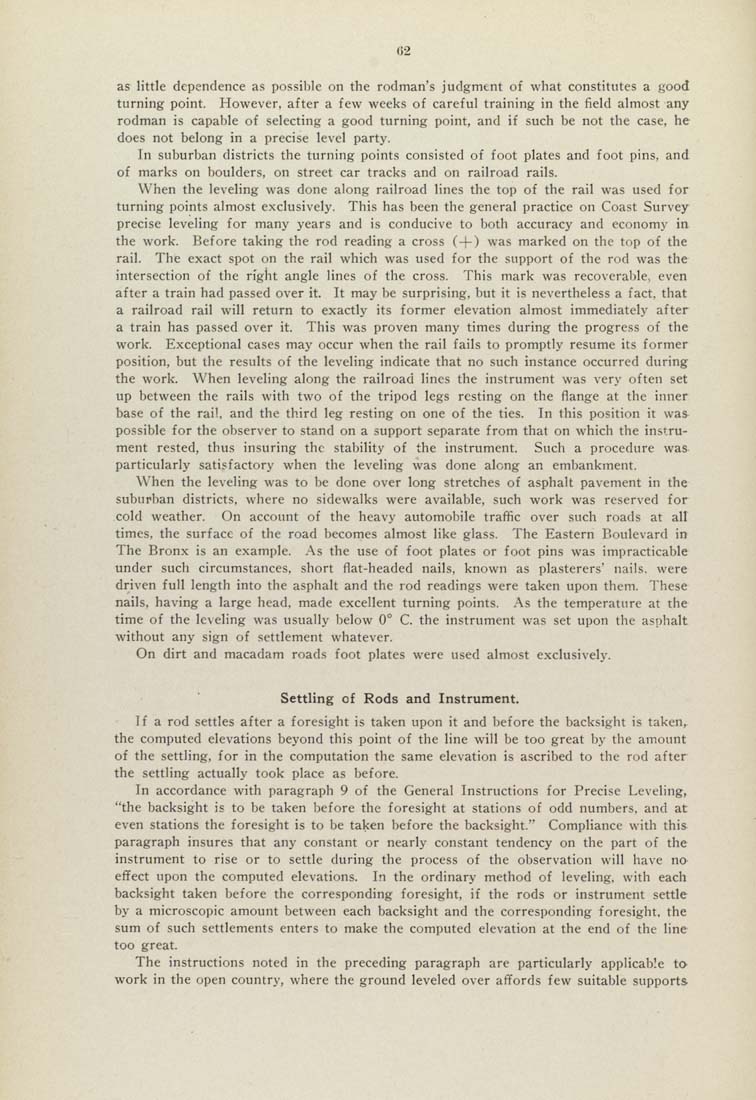02
as little dependence as possible on the rodman's judgment of what constitutes a good
turning point. However, after a few weeks of careful training in the field almost any
rodman is capable of selecting a good turning point, and if such be not the case, he
does not belong in a precise level party.
In suburban districts the turning points consisted of foot plates and foot pins, and
of marks on boulders, on street car tracks and on railroad rails.
When the leveling was done along railroad lines the top of the rail was used for
turning points almost exclusively. This has been the general practice on Coast Survey
precise leveling for many years and is conducive to both accuracy and economy in
the work. Before taking the rod reading a cross (-|-) was marked on the top of the
rail. The exact spot on the rail which was used for the snpport of the rod was the
intersection of the right angle lines of the cross. This mark was recoverable, even
after a train had passed over it. It may he surprising, but it is nevertheless a fact, that
a railroad rail will return to exactly its former elevation almost immediately after
a train has passed over it. This was proven many times during the progress of the
work. Exceptional cases may occur when the rail fails to promptly resume its former
position, but the results of the leveling indicate that no such instance occurred during
the work. When leveling along the railroad lines the instrument was very often set
up between the rails with two of the tripod legs resting on the flange at the inner
base of the rail, and the third leg resting on one of the ties. In this position it was
possible for the observer to stand on a support separate from that on which the instru¬
ment rested, thus insuring the stability of the instrument. Such a procedure was
particularly satisfactory when the leveling was done along an embankment.
When the leveling was to be done over long stretches of asphalt pavement in the
suburban districts, where no sidewalks were available, such work was reserved for
cold weather. On account of the heavy automobile traffic over such roads at all
times, the surface of the road becomes almost like glass. The Eastern Boulevard in
The Bronx is an example. .As the use of foot plates or foot pins was impracticable
under such circumstances, short flat-headed nails, known as plasterers' nails, were
driven full length into the asphalt and the rod readings were taken upon them. These
nails, having a large head, made excellent turning points. As the temperature at the
time of the leveling was usually below 0° C. the instrument was set upon the asphalt
without any sign of settlement whatever.
On dirt and macadam roads foot plates were used almost exclusively.
Settling of Rods and Instrument.
Tf a rod settles after a foresight is taken upon it and before the backsight is taken,
the computed elevations beyond this point of the line will be too great by the amount
of the settling, for in the computation the same elevation is ascribed to the rod after
the settling actually took place as before.
In accordance with paragraph 9 of the General Instructions for Precise Leveling,
"the backsight is to be taken before the foresight at stations of odd numbers, and at
even stations the foresight is to be taken before the backsight." Compliance with this
paragraph insures that any constant or nearly constant tendency on the part of the
instrument to rise or to settle during the process of the observation will have nO'
effect upon the computed elevations. In the ordinary method of leveling, with each
backsight taken before the corresponding foresight, if the rods or instrument settle
by a microscopic amount between each backsight and the corresponding foresight, the
sum of such settlements enters to make the computed elevation at the end of the line
too great.
The instructions noted in the preceding paragraph are particularly applicable ta
work in the open country, where the ground leveled over affords few suitable supports
|








